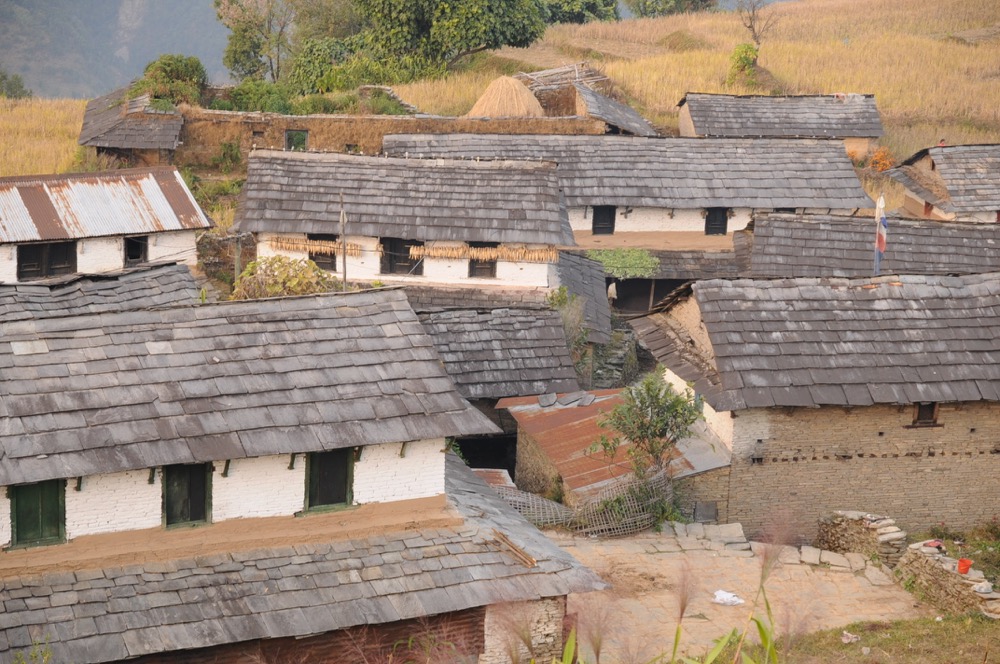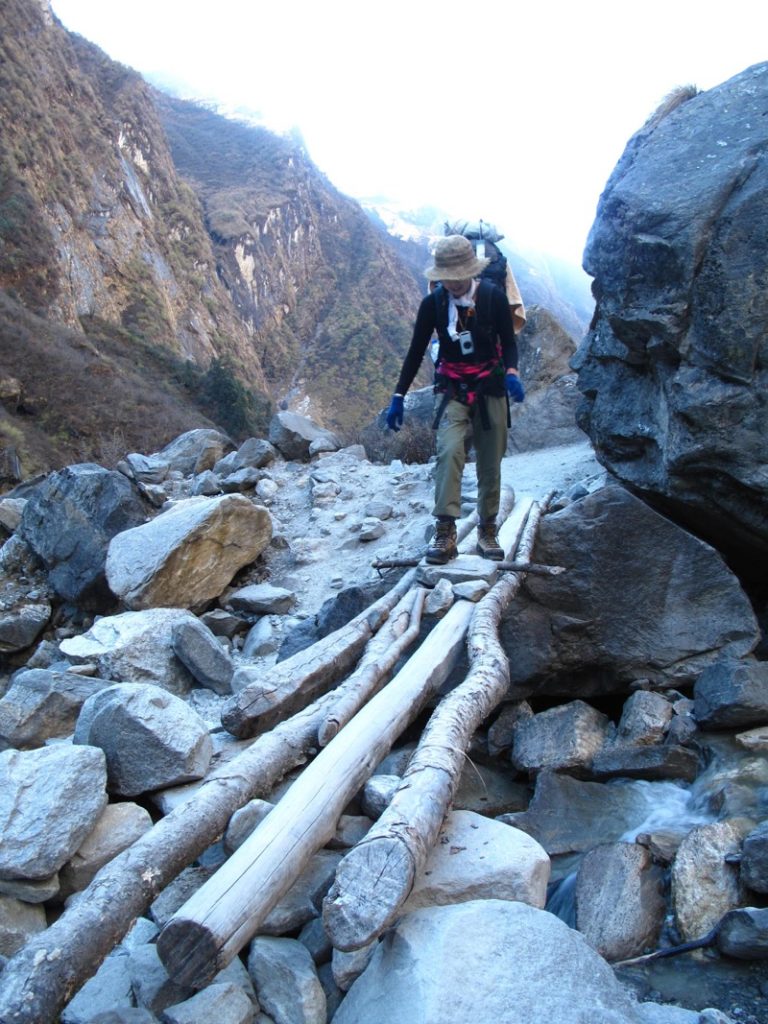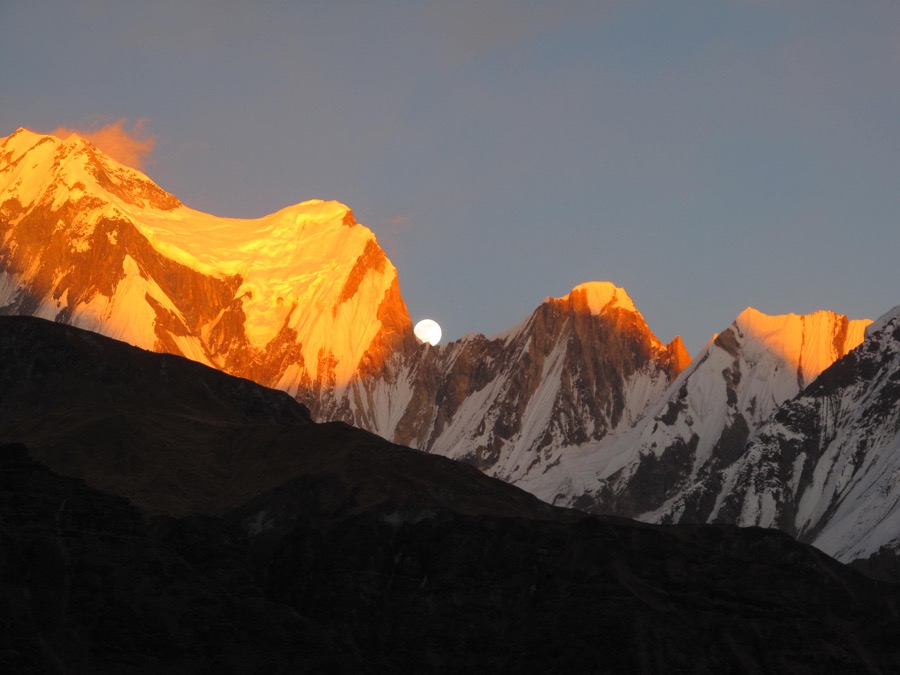For many people Nepal means Mount Everest. But for those who have ever been to Nepal, whether for trekking or general sightseeing, what they take away with them is the majesty and magic of the Annapurna mountain range. Annapurna means ‘goddess of plenty’ in Sanskrit. And that has to be an understatement! Annapurna itself is not just one but four peaks. And there is not just one trekking route through this ever changing landscape but enough to keep everyone happy from the novice trekker to those with a lifetime of experience.
Regardless as to which trek you take Annapurna base camp, Annapurna circuit, or one of the treks that takes you into Upper Mustang and other connected areas, you will find yourself instantly in the heart of the mountains from Day 1! In fact for those of you after a more relaxed experience by exploring the lakeside town of Pokhara, you will find yourself dominated by Macchapucchre without hiking at all!
In this blog we will be looking at the Annapurna base camp trek. Also known as the ABC trek, Annapurna sanctuary trek and Annapurna south trek. Yes, these are basically the same trek!

On the Annapurna base camp trek the mountains on display are Macchapucchre (Better known as Fish Tail), Mount Hiunchuli, Annapurna South, Annapurna I, and Annapurna III, and more. At the Annapurna sanctuary there is a 360 degree panorama and a near vertical view of the south face of Annapurna, as well as views Hiunchuli, Gangapurna, and Macchapucchre Himal. The Annapurna sanctuary gives you ring of snow covered peaks over 7000 m an amphitheater of glaciers, rock and snow.
Aside from the mountains the trails pass through Gurung villages, terraced farmland, forests, including those famous rhododendron bushes, over fast flowing icy rivers and passed waterfalls and deep gorges. The highest point on this trek is 4130 m at Annapurna base camp. So while this is considered ‘high altitude’ being that it is a gentle increase in altitude, altitude sickness should not present the majority of trekkers with problems.
The ABC trek is also possible to do with children. A shorter trek for those with children is the Poon hill trek. Poon hill is part of the ABC Trek which can be included in the longer trek, omitted from the ABC Trek or done as a stand alone trek.
And btw, if you are thinking of doing the Annapurna circuit trek, that is completely different to the ABC or Annapurna sanctuary trek!
Getting There
Annapurna is the best loved trekking region in Nepal for two reasons the mountains and the ease of access.
To start the ABC trek, you need to travel to Pokhara. Pokhara is a wonderfully relaxed lake side town which also has a vibrant nightlife as well as interesting sightseeing options.
Although only 210 km from Kathmandu, it takes considerable time to get there. Don’t be fooled by the low mileage figure! By road it will take you around seven hours! By flight it will take you 20 minutes! You need to balance the time involved by road by the money involved in flying!
From Pokhara it’s then a short ride to the start of the trek.
Getting To Pokhara
- By road
Depending on whether you take a tourist bus or a private car the cost will vary from USD 8 per person to around USD 140 for a car. The time is the same, approximately seven hours including a lunch stop.
- By air
There are several airlines that fly Kathmandu to Pokhara. It will cost around USD 110 per person and take 20 minutes. Morning flights are best and it’s like getting a free mountain flight!
Getting To The Start Of The ABC Trek

You can start the ABC trek from either Naya Pool or Phedi.
To either of these places you can take a local bus from the Zero Kilometer or Baglung bus park or a taxi from anywhere in Lakeside Pokhara.
It takes approximately 90 minutes to reach Naya Pool and 45 minutes to reach Phedi.
Should You Go With Or Without A Guide?

While some treks in Nepal, such as treks in the Manaslu and Kanchenjunga, make it compulsory to take a guide (Basically for your own safety in remote areas), you are not legally bound to take a guide for trekking in the Annapurna.
If you buy a good map, be sensible, and take information from the guest houses along the trails where you will be eating and sleeping, it is entirely possible. You can also stock up on your own supplies for the trek in Pokhara or Chomrong on the route.
But like everything, there is an upside and a downside to trekking without a guide.
Pros Of Having A Guide
- It can be more fun than trekking alone there is always someone to talk to and joke with. Sure, there are other trekkers on the trails but there might be some days (Depending on the season) when there is no one.
- Your guide will pre book your accommodation. In the busy seasons many guesthouses are full. It’s not unusual to see trekkers sleeping in the dining room or having to double up their room with others. And definitely you don’t want to have to walk extra kilometers to look for another lodge at the end of a long day.
- You guide will be there to support you. Either through encouragement or in those times when the trail is not clear or a bit tricky. If you are injured, your guide is there to arrange for help.
- You guide is a source of information! Guides know the local culture and are knowledgeable about the mountains. You don’t want to miss out on something like a local festival happening just around the corner or being unable to name the peaks in your photographs.
Cons Of Having A Guide
- Often buying a package trek is more expensive than doing it alone. But do research before you buy prices vary considerably!
- You can be more independent and flexible. If you want to spend more time at that lovely lodge by the river then you can! Meet an interesting person on the trail and want to pair up? You can if you don’t have a guide!
- You are free to choose where you eat and sleep. Guides have favourite spots and guesthouses. If you are on your own you can chose where you want to stay. Keeping in mind accommodation is scares during peak trekking seasons!
Trekking Routes
Another reason why the Annapurna is such popular trekking destination is there is so much choice of routes. You can make your trek as long or short as you chose from 8 to 12 days. Or even shorter if you wish to only trek to Ghorepani Poon Hill.
There are several starting points also depending on your interest.
Recommend Itinerary With Ghorepani Poon Hill

If you have more time, I recommend including the Ghorepani Poon Hill section into your ABC trek. This is for two reasons. Firstly, it gives you more time to acclimatize. Secondly, why miss the great views from Poon Hill?
Here is the itinerary of the ABC Trek which includes Ghorepani Poon Hill:
[table id=3 /]
Recommended Itinerary Without Ghorepani Poon Hill

It will take you eight days to trek from Pokhara to Annapurna base camp and back to Pokhara. This is great for those with limited time. On the down side there is an almost 1000 m rise in altitude between Deurali and Annapurna base camp so I would recommend doing this trek alone only if you are experienced and comfortable with altitude.
Here is the itinerary of the ABC Trek which excludes Ghorepani Poon Hill:
[table id=4 /]
Annapurna Base Camp Trek Map
I suggest if you are trekking independently you buy a map. In the meantime here is a link to an online map to help your plan your trip, but do not rely on the online map when you are trekking. Internet or power to charge your phone may not be available in all areas.
How Difficult Is The Annapurna Base Camp Trek?
Despite what some agents may advertise, there are no really ‘easy’ treks in Nepal! They might well be easy for those who have lived their whole lives in the mountains or for those who are professional trail runners but, frankly, that’s not most of us!

Having said that, the ABC trek route is very well supported in terms of comfortable guesthouses with facilities such as telephones, hot showers and good food. The trails are well marked and there should be no problem in following the route (But do be aware in bad weather things may be more difficult and care should always be taken to stay on the correct path).
With the ups and downs you find on all treks in the Himalaya’s you need to be fit to tackle the Annapurna base camp trek. Not to athlete standards just not a couch potato!
Best Time To Do The Annapurna Base Camp Trek

While some people do trek this route throughout the year I belief it is best NOT trekked in the winter. With the high level of snow and freezing temperatures and some higher altitude lodges being closed as the locals make their way to Pokhara or Kathmandu for the winter, things can also be logistically difficult.
Definitely the best time is Autumn and Spring. That is September to November and March to May. Naturally the trails will be busier at that time but that also makes for good company and conversation in the evenings.
For those die hard trekkers, it is possible to do this trek during the monsoon (summer) but be aware of slippery trails and leeches!
Note: There is a potential avalanche hazard in between Deurali and Fishtail Base Camp, so try to cross the area early in the morning. Always listen to local and ask for advice.
Accommodation & Food On The ABC Trek
This is probably the oldest commercial trekking route in Nepal. And the best loved. As a result the guesthouses, usually called teahouses, are some of the best in the country. As far as Chomrong Village the teahouses are in local villages. Further up the train the teahouses have been built specifically for trekkers.

Although some of the lower teahouses are very comfortable, expect basic standards as you move further up the trail. Most sleeping rooms are equipped with two beds, but some may sleep up to eight. The mattress will be thinner than what you are used to and they will supply a pillow and blanket. But bring your own sleeping bag! For both warmth and hygiene.
As the cost of sleeping in a teahouse is relatively low, the owners make income off the food. So there is a rule, which will be enforced (!) about eating where you sleep. To avoid unfair competition, each teahouse serves the same menu and prices, as regulated by the authorities. Despite this, the food is surprisingly good. And dal bhat comes with unlimited refills! Do expect the prices to increase along with the altitude!

As rule of thumb, carry around Rs 2500 to 3000 per day to cover accommodation and meals. This will NOT cover drinks and charging your batteries (For which there is a cost) etc. Bring more cash for these things. You will not find an ATM on the route and teahouses will not accept cards as payment. If you find you have too many rupees left over you can always spend them in the shops and bars in Lakeside or Thamel to celebrate your trek! Or convert them back at the money exchanges.
Drinking Water

In this area mineral water is banned in order to reduce the number of plastic bottles which are left along the trails. So the alternative is to bring your own sterilizing method (drops, tablets, filters) or buy safe drinking water from the teahouses. You can collect tap water for free (but DO sterilize) or pay for safe drinking water.
Permits for Annapurna Base Camp Trek
Like all treks in Nepal you will require permits to trek to Annapurna base camp.
If you are trekking through an agency, then they will arrange your permits for you. Simply hand them two photographs and some money and they will do the rest!
If you are doing the trek independently you will need to obtain your own permits. You can do this in Kathmandu at the NTNC Office at the Nepal Tourism Board on Exhibition Road (15 minutes walk from Thamel), or in Pokhara at the NTNC Office at Dam Side (30 minutes walk from Lakeside). Simply ask for the form, complete it, and hand over your money and four (4) photographs!
For the Annapurna Base Camp Trek you need two permits:
- TIMS Card at Rs 2000 per person
- Annapurna Conservation Area Project Permit at Rs 3000 per person
Annapurna Base Camp Trek Cost
Guided treks vary in price for the same areas depending on the number of days and the services you choose. But on average it will cost you around USD 480 to USD 550 for the ABC Trek.
If you chose to trek to ABC independently, the cost will depend on how many beers and extras you have! Some things are compulsory expenditures, like food and accommodation. Basically you should calculate USD 25 to USD 30 per day, plus an additional USD 50 for permits, USD 40 for transport. In total an average USD 290 to USD 350 for your independent trip.

Conclusion
It is not for nothing that the Annapurna are so well loved by visitors to Nepal. And it is not for nothing that the Annapurna base camp trek is among the most popular in the country. Suitable for almost everyone and highlighting the best that Nepal has to offer in terms of mountains, landscapes, culture and people it’s a trek that you aren’t going to forget. And of course, as soon as you arrive in Pokhara you feel like you are in the heart of the mountains because you are!
